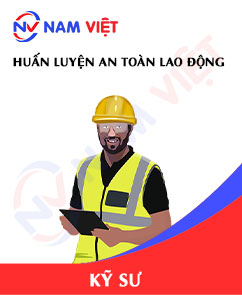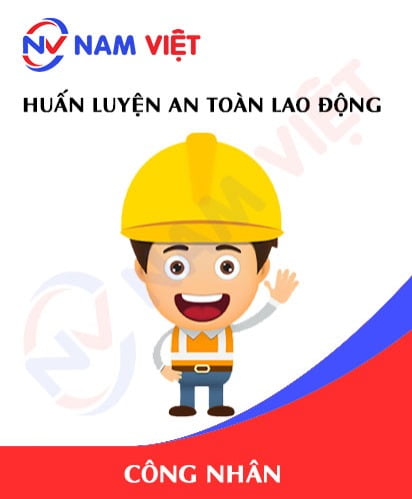Occupational Safety Training for Chefs
99,000 ₫
Note: The above price is calculated for one person, and the price may fluctuate depending on the number of learners participating in the course and market movements. For more accurate pricing support, please refer to the price list or contact our consulting staff directly.
The Safety Training Course for Chefs is a course that equips knowledge of group 3 occupational safety. The course will enhance learners’ awareness of how to prevent workplace accidents during the manufacturing process. Accordingly, occupational safety training content is closely aligned with Article 18 Decree 44/2016/ND-CP.
Table of Contents
Toggle1. Overview of Chef
a. The important role of Chef
Chefs, including head chefs and sous chefs, play an extremely important role in the restaurant industry and culinary services. Below are some key roles that chefs take on:
- Menu design and development: Chefs master knowledge of dishes, cooking methods, and combinations to create delicious meals. They provide ideas, design, and develop menus based on flavors, styles, and the requirements of restaurants or customers.
- Management and planning: Chefs are responsible for managing kitchen activities. They determine the necessary ingredients, plan the cooking process, and ensure sufficient preparation to meet customer demand.
- Cooking and food preparation: This is the main duty of chefs. They must have good cooking and preparation skills to create tasty and attractive dishes. Chefs must know how to use cooking techniques, choose the best ingredients, and ensure food quality.
- Ensuring hygiene and food safety: Chefs must comply with hygiene and food safety regulations to ensure that dishes are prepared under safe conditions and do not harm the health of customers.
- Leadership and training: Chefs act as leaders in the kitchen and must have the ability to manage a team of staff. They must train and guide employees on cooking skills, hygiene, and kitchen workflows.
- Innovation and creativity: Chefs are often required to innovate and create unique dishes that meet customer expectations. They must follow culinary trends, research, and apply new ideas to enhance the dining experience.

b. Chefs in different fields
Chefs not only play an important role in the restaurant and culinary services industry, but they can also take part in many other professional fields. Below are some examples of the roles of chefs in different areas:
- Hotels and resorts: In the hotel industry, chefs can work in hotel restaurants and dining areas, taking on an important role in providing high-quality culinary services for customers. They may participate in menu design, food preparation, and ensuring hygiene and food safety standards.
- Aviation: In the aviation industry, chefs often work for airlines or on long-haul flights. Their role is to prepare and serve meals for passengers, ensuring menu quality and variety while complying with hygiene and food safety regulations.
- Food industry: In food factories and processing enterprises, chefs can play an important role in research and product development, creating unique and efficient food processing recipes. They may also take on management and staff training roles in the food manufacturing process.
- Media and television: Chefs can also participate in media and television, working in live cooking programs or producing food-related content. They can serve as hosts, cooking experts, or take part in content production and editing related to cuisine.
- Education and training: Chefs can play a role in education and training, becoming lecturers or trainers specializing in culinary arts.

2. Overview of occupational safety training course for Chef
a. What is occupational safety training for Chef?
- Occupational safety training for Chefs consists of lessons that provide awareness of how to prevent workplace accidents for employees. Accordingly, Chefs belong to group 3.
- The occupational safety training course will help employees recognize and avoid hazards, thereby reducing the risk of workplace accidents while working.
REGISTER FOR OCCUPATIONAL SAFETY TRAINING SERVICE
b. Training duration
First-time occupational safety training duration
- Total training duration is at least 24 hours, including test time.
- 8 hours of theoretical study on the system of occupational safety and hygiene policies and laws
- 8 hours of theoretical study on basic occupational safety and hygiene knowledge
- 4 hours of theoretical study on specialized training content
- 2 hours of practical training on specialized training content
- 2 hours of theoretical examination at the end of the course
The occupational safety training center will divide the schedule into several sessions depending on the arrangement for Chefs. Normally, there will be 6 training sessions held over 3 days, provided that the manufacturing enterprise arranges continuous learning time.
Periodic occupational safety training duration
- Before the occupational safety card expires, employees who want renewal must attend a periodic occupational safety training course, with a periodic training duration of at least 50% of the first-time training duration.
Explanation: The total periodic occupational safety training duration is at least 12 hours, including test time. After completing the periodic training course and passing the examination, employees will be reissued or extended the occupational safety card.
c. Content of the training course
| No. | TRAINING CONTENT | TRAINING DURATION (HOURS) | |||
| Total | Including | ||||
| Theory | Practice | Test | |||
| I | System of occupational safety and hygiene policies and laws | 8 | 8 | 0 | 0 |
| 1 | Overview of the system of legal documents on occupational safety and hygiene. | 6 | 6 | ||
| 2 | System of occupational safety and hygiene standards and technical regulations. | 1 | 1 | ||
| 3 | Specific regulations of state management agencies on occupational safety and hygiene when constructing new, expanding, or renovating works, facilities for production, use, storage, preservation, and inspection of machines, equipment, materials, and substances subject to strict requirements on occupational safety and hygiene. | 1 | 1 | ||
| II | Basic knowledge of occupational safety and hygiene | 8 | 8 | 0 | 0 |
| 1 | Basic knowledge of hazardous and harmful factors in the workplace. | 4 | 4 | ||
| 2 | Methods of improving working conditions. | 1 | 1 | ||
| 3 | Safety culture in manufacturing and business. | 1 | 1 | ||
| 4 | Rights and obligations of employers and employees; policies and regimes on occupational safety and hygiene for employees; functions and duties of the occupational safety and hygiene network. | 1 | 1 | ||
| 5 | Occupational safety and hygiene regulations, safety signs, instructions, and use of safety equipment and personal protective equipment; skills in first aid for workplace accidents, and prevention of occupational diseases. | 1 | 1 | ||
| III | Specialized training content | 6 | 4 | 2 | 0 |
| General knowledge of machines, equipment, substances that generate hazardous factors; analysis, assessment, and management of occupational safety and hygiene risks; safe working procedures with machines, equipment, and substances subject to strict occupational safety and hygiene requirements. | 6 | 4 | 2 | ||
| IV | Examination of occupational safety training content at the end of the course | 2 | 2 | 0 | 0 |
| Total | 24 | 22 | 2 | ||
See more training content of 6 groups
d. Occupational safety card
After completing the occupational safety training course and passing the examination, employees will be issued an occupational safety card (commonly referred to as a occupational safety certificate for group 3).
The group 3 safety card will clearly show information such as full name, date of birth, job title, and specific working environment. It also includes training duration, a red stamp, and a signature certifying completion of the training course.
According to the regulations on issuing safety cards specified in clause 2 of article 24 of decree 44/2016/ND-CP, it is divided into 2 cases:
- In case the employer and the employee have a labor contract, the employer must sign, stamp, and seal the safety card for group 3 employees after completing the training course from the occupational safety training unit and passing the examination.
- In case of freelance or seasonal workers without a labor contract, the training unit must sign, stamp, and seal the safety card for workers after they complete the training course from the occupational safety training unit and pass the examination.

3. What dangers do chefs usually face
Chefs are often exposed to many dangers that can affect their health. Below are some common hazards that chefs may encounter:
- Risk of fire and burns: Chefs work near high heat sources such as fire, stoves, ovens, which can increase the risk of fire and burns. They need to follow safety rules when working with flames and ensure alertness during cooking.
- Exposure to chemicals: Chefs use many cleaning agents, disinfectants, and other chemicals during work. Long-term and improper exposure can cause skin irritation, infections, and other health problems. They need to follow rules on use and personal protection when handling these chemicals.
- Risks related to knives and tools: Chefs use knives and sharp tools in food preparation. Carelessness when using knives can lead to accidents and injuries. Chefs need safety skills when working with knives and should always keep knives sharp and clean.
- Injury from hot materials: Chefs often come into contact with hot materials such as hot pots, hot bowls, and other items. Improper contact can cause burns or injuries. They need to follow safety rules when handling hot materials and use personal protective equipment when necessary.
- Chemical poisoning and environmental pollution: In some cases, chefs may be exposed to toxic substances such as poisonous gases, smoke, oil vapors, and chemicals in the work environment.

4. Safety measures for chefs
To ensure the safety of chefs and avoid occupational hazards, there are several important safety measures that need to be followed. Below are some essential safety measures that chefs can apply:
- Training and education: Chefs need to be trained in occupational safety and safety rules in the culinary industry. This includes understanding safe working procedures, correct use of tools and equipment, and knowing how to handle emergencies.
- Use of personal protective equipment: Chefs need to use personal protective equipment such as helmets, protective clothing, safety glasses, gloves, and anti-slip shoes. This helps protect them from potential dangers such as fire, burns, cuts, slips, and impacts.
- Food hygiene and safety: Chefs must comply with food hygiene and safety rules to ensure that food is prepared in safe conditions and does not harm health. This includes maintaining personal hygiene, cleaning kitchens and equipment, and controlling temperature and storage time of food.
- Fire risk management: Chefs should be trained in fire risk management. They need to know how to safely use and store heat sources such as fire and cooking equipment. In addition, regular inspection and maintenance of electrical and gas equipment is necessary to ensure safety.
- Management of sharp tools: Chefs need to ensure that knives and sharp tools are used and stored safely. They should follow rules for using knives and maintain blades properly.
- Regularly organize occupational environment monitoring in factories, collect and analyze harmful factors for workers, thereby adjusting to reduce risks and prevent occupational diseases for them.
5. Salary and benefits of chefs
The salary and benefits of chefs often depend on many factors such as country, experience, workplace, and type of business. Below is an overview of chef salaries and benefits:
- Salary: The salary of chefs can vary greatly, from low levels for beginners to high salaries for experienced and talented chefs. In some countries and prestigious restaurants, top chefs can earn high salaries, while in other places, salaries may be lower. Chefs may receive basic salary, bonuses, night shift allowances, service charges, and other income.
- Benefits and insurance: Chefs may enjoy benefits such as health insurance, accident insurance, unemployment insurance, and retirement insurance from the restaurant or company they work for. However, the level and type of benefits may vary depending on the country and specific restaurant.
- Flexible working hours: The culinary industry often has irregular working hours, with morning, evening, weekend, and holiday shifts. This can provide flexibility in scheduling but also create pressure and require readiness to work overtime.
- Promotion opportunities: Chefs may have opportunities to advance and grow in the culinary industry. With appropriate skills and experience, they can become head chefs, restaurant directors, or open their own restaurants.
- Creative working environment: One of the non-financial benefits of being a chef is a creative and exciting working environment.
6. Benefits of occupational safety training
An Toan Nam Viet provides your business with great benefits after completing occupational safety training courses as regulated in Decree 44/2016/ND – CP on occupational safety and hygiene for companies, factories, enterprises.
- Employees can identify potential risks of occupational accidents and take preventive measures to avoid accidents.
- Your business can establish risk prevention measures in manufacturing, operation, and maintenance processes.
- Minimize costs when safety risks occur in the workplace.
- Uninterrupted manufacturing processes will help increase labor productivity and product quality.
- Strictly comply with occupational safety regulations, avoiding legal risks.
- Create credibility and professionalism in all aspects, thereby enhancing the brand reputation of your business.
Training courses of Nam Viet are the solution to prevent and protect individuals from external risk factors so that they can avoid dangers that could lead to injury or even death.
REGISTER FOR OCCUPATIONAL SAFETY TRAINING SERVICE
7. Customer feedback after completing the training course
An Toan Nam Viet has many years of experience in its mission of accompanying many businesses in Vietnam in general and especially in the southern provinces. That responsibility for Nam Viet is extremely valuable, which is why the occupational safety training work of Nam Viet is always increasingly professional. The motivation for An Toan Nam Viet to grow stronger today comes from positive feedback as well as suggestions from businesses. Below are feedback from our partners we have served.
Bac Nam E&C Construction Investment Joint Stock Company
“The first time I used the service at An Toan Nam Viet, I was very surprised by the enthusiastic 24/7 support of the consulting team. The class organization was very quick and convenient for our company, thank you very much for the service of Nam Viet!”
Hoa Dat Construction and Trading Joint Stock Company
“The service of Nam Viet has helped us a lot in simplifying occupational safety and completing safety documentation for the work process. The consulting team was enthusiastic and timely in addressing our questions. 5 stars for Nam Viet”
See more customer interviews after using the service of An Toan Nam Viet
8. Occupational safety training capacity of An Toan Nam Viet
An Toan Nam Viet is a prestigious and quality occupational safety training center in Vietnam today. With continuous occupational safety training sessions held at manufacturing workshops, factories, or construction sites across the country (63 provinces and cities in Vietnam).
REGISTER FOR OCCUPATIONAL SAFETY TRAINING SERVICE
License for occupational safety training
- An Toan Nam Viet has been inspected and certified by the Occupational Safety Department of the Ministry of Labor – Invalids and Social Affairs as eligible for occupational safety and hygiene training activities. This further strengthens our occupational safety training capacity.

Materials and lectures
- Before occupational safety training materials are included in training courses, they have been reviewed and approved to ensure the lectures are always accurate and effective when applied.
- The teaching methods of instructors are standardized according to the teaching standards of An Toan Nam Viet, methods that occupational safety and hygiene training experts have researched and developed to bring the highest learning efficiency to trainees.
Facilities
- Controlling classroom factors that affect the training process will increase teaching efficiency and knowledge absorption of learners.
- Training support facilities of ours always arrange spacious classrooms that meet standards in terms of area, lighting, training equipment, etc.
9. Prestigious and quality nationwide occupational safety training center
At An Toan Nam Viet, we always put our professional commitment to occupational safety training as the top priority. For us, imparting self-protection knowledge to chefs so that they can have safe preparation on their livelihood path is contributing to nation building.
To ensure training effectiveness, we carefully and meticulously prepare every detail, no matter how small. From preparing teaching tools, equipment, curriculum, materials, sound, and lighting.
Our occupational safety trainers are experts with many years of experience in the field. They even have research projects on identifying hazards in all professions and how to prevent them.
Lectures from trainers are summarized from practice and delivered vividly and understandably to workers. These factors help workers feel comfortable during learning and absorb our teaching knowledge well. Of course, the knowledge delivered always complies with Decree 44/2016/ND-CP.
From there, learners can grasp many measures to prevent dangers and how to protect themselves. At the same time, they can apply them appropriately in actual work.
Our occupational safety training center is proud to be a provider of prestigious and professional occupational safety training services with the following advantages:
- Competitive training costs but training quality is still guaranteed.
- Flexible training schedules in line with the company’s manufacturing situation.
- Quick occupational safety training certification procedures, in accordance with the Law.
- Trainers are people with many years of experience in the profession.
- Classrooms are controlled for factors affecting the training process to increase teaching efficiency and knowledge absorption.
- Lectures are compiled in accordance with occupational safety at enterprises.
- An Toan Nam Viet works dedicatedly and professionally to support customers accurately and quickly.

10. Refer to more occupational safety training materials
1 review for Occupational Safety Training for Chefs
No comments yet















caotiensyhung.07081999
Ok tốt lắm